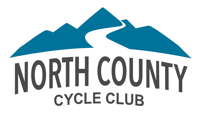E-bikes are a great way for more cyclists to enjoy group bike rides. However, with that extra power comes extra responsibility. Our goal is for all cyclists, whether they have motor assist or not, to be able to ride together safely, with camaraderie, and good rapport. To that end we welcome cyclists on e-bikes and request they abide by the following policy.
NCCC allows e-bikes on NCCC rides provided:
- That NCCC rides travel at human-powered bike speed. E-bike cyclists must ride at the speed of the group.
- That E-bike cyclists are expected to safely blend in with human-powered cyclists.
- That E-bike cyclists should ride courteously with cyclists who have no motor assist. This includes:
- Safely passing human-powered cyclists, especially on hills.
- If ahead of the group, stopping at the next regroup point, especially at the top of climbs.
- That E-bike cyclists acknowledge the ride leader has the right to ask anyone to leave the group for unsafe or discourteous behavior.
- That only Class 1 (20 mph pedal assist) or Class 3 (28 mph pedal assist) e-bikes are allowed on NCCC rides. Class 2 e-bikes (throttle assist) are not allowed on NCCC rides. E-bikes without a Class 1, 2, or 3 label are illegal on CA roads and void our NCCC insurance.

